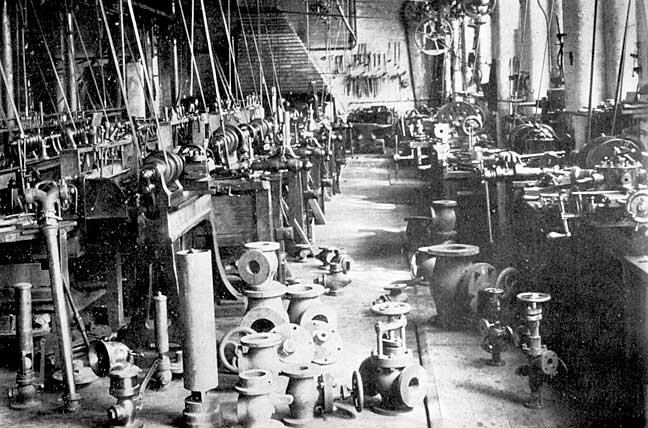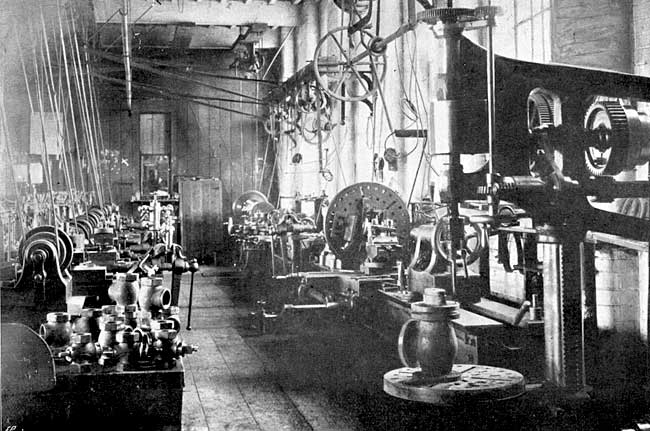< Previous | Contents | Next >
Mr. Smith was born in Derby in 1803, and was educated at Repton Grammar School, afterwards joining his father in practice as a civil engineer. From an early age he gave decided evidence of a taste for practical mechanics, and by his invention of the Steam Pressure Gauge in 1847, his name sprang into prominence in the engineering world, where the new appliance received the warmest support from the great George Stephenson, in whose life, by Smiles, the following interesting letter as well as an account of an interview with Mr. Sydney Smith appear :—
Previous to the introduction of the steam gauge its functions were fulfilled by a frail and primitive instrument known as a "Mercury Bob." Sometimes this bob would stick, frequently the tube containing the mercury burst, the sudden rise of steam would blow the mercury out of the tube, and the accumulation of dirt in and outside the tube rendered the indication difficult, and its numerous defects made the apparatus both inefficient and unsafe in operation.
In common with the great majority of inventors, Mr. Sydney Smith's claim to the original honour of discovery became the subject of controversy in an American journal, the Locomotive Engineer, which gave currency to a statement that this valuable invention was first brought out by a Frenchman in 1850.
In confutation of this error it will suffice to call attention to above letter written by George Stephenson, and dated October 15th, 1847.
Additional evidence of the justice of Mr. Smith's claim to the honour of this valuable invention is furnished in a communication addressed to him by Mr. Samuel Thos. Davenport, of the Society for the Encouragement of Arts, etc., dated October 21st, 1847.
In his letter the writer requests the inventor to furnish the Society with a paper explaining the apparatus, of which it was also suggested a model should be submitted for inspection at the following session of that body. An extract from the Illustrated London News, 1849, gives further proof that the indicators had been in constant work for upwards of two years at the Royal Arsenal, Woolwich, and establishes beyond doubt that Sydney Smith's Steam Pressure Gauge was at that time an actual and accomplished fact.
Among other inventions due to Mr. Smith's fertility of invention may be enumerated the Rotary Steam Engine, a Rotary Stocking Frame, a Spring Safety Valve for regulating the pressure of steam in boilers, a Self-Acting Damper Regulator for engine furnaces, and a portable gas apparatus for use in public and domestic institutions. The principal of the last invention has been successfully applied in the lighting of railway stations.
It is of interest to note that Mr. Sydney Smith received no national recognition of the great benefit conferred upon mankind by his invaluable invention of the steam gauge, which it is no exaggeration to state has saved thousands of human lives and property of incalculable value since its introduction half a century since.
Retiring from active business about the year 1860, Mr. Smith died in 1882, and his three sons, Samuel, Isaac, and William Smith, continued the business of brass founders and finishers and steam gauge makers, at Basford, having built a new works there, which was specially designed for carrying on more efficiently their trade. Through the death of Mr. Samuel Smith, the business is now continued by Isaac and William Smith, the present owners of the Basford Brass Works.

Corner of Brass Finishers' Shop.
These gentlemen give evidence by their numerous patents that they have inherited the inventive genius of their father, the last invention of the senior partner being the "Steam Syren," an apparatus designed for the prevention of collisions at sea during darkness or fog, which is now in universal use in the mercantile marine of our own and other countries. One of these patent syrens was recently fitted to the Czar's Imperial yacht "Standart," and many have since been supplied to the Russian Navy. Mr. Isaac Smith, notwithstanding the heavy demands upon his time involved in the direction of a large business, yet finds leisure to devote to the public service the benefit of his varied experience.

Corner of Iron Valve and Heavy Brass Cocks Shop.
Commencing his public career as a member of the Radford Local Board, Mr. Isaac Smith was afterwards elected a Guardian of the Poor for that district of the county, and later was chosen a representative of Sherwood Ward in the Nottingham Town Council, in which he occupied a seat for many years. He is also closely identified with the principal political organisations and commercial boards in the district, and has long held a prominent position in the Wesleyan body, by whom he is widely esteemed, having fulfilled the duties of representative of the Nottingham Churches at the annual Conference, and is now one of the oldest members of the District Synod.

